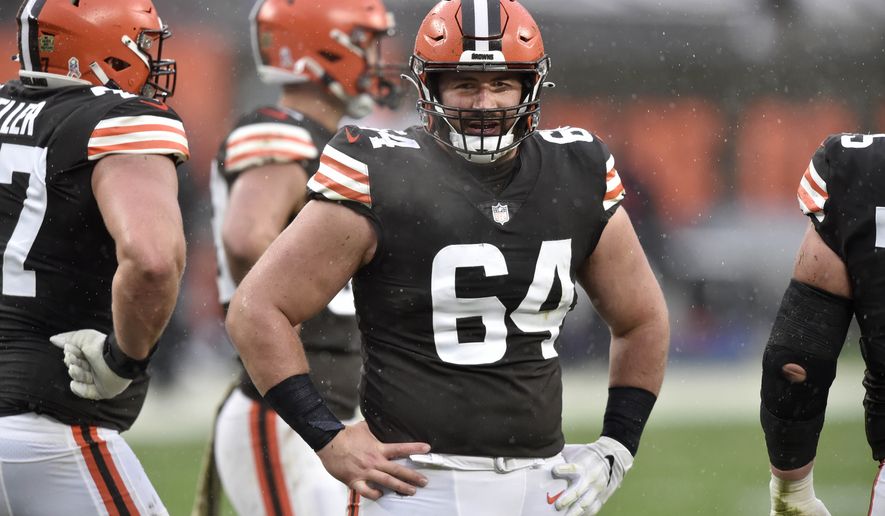When the NFL’s voluntary offseason workouts began Monday, there was no on-field contact. But between the league and the players’ association, there have been ample off-field clashes already.
Players from more than half the teams in the NFL have announced they won’t participate in the league’s voluntary offseason workouts, a decision made with the coronavirus pandemic in mind but one that includes, spokesmen say, other factors.
According to union representatives, the league’s “voluntary” workouts often end up with teams coercing players into attending, a violation of the collective bargaining agreement. What’s more, a dramatic drop in player injuries last season proves, according to the union, that in-person offseason workouts aren’t necessary — and actually may be doing more harm than good.
J.C. Tretter, a Cleveland Browns offensive lineman and the union president, credited last year’s virtual workouts for a 23% decrease in missed-time injuries during the season. And concussions, he said, were down 30%.
“All those issues, guys talk about and realize that this doesn’t make sense,” Tretter said. “This isn’t necessary. It’s not exactly safe. And if we’re in the middle of a pandemic, why are we doing things that aren’t necessary?”
The league and players’ association were unable to strike an agreement this offseason over how workouts should look, with the union pushing for a fully virtual program mirroring last year’s when players worked out on their own before August training camps began. The player associations’ proposal allowed for a mandatory minicamp to take place in June.
But the NFL rejected that proposal, instead passing an offseason program plan last week without union approval. The plan, according to NFL Network, consists of three phases. The first began Monday in a mostly virtual environment — teams could hold up to two hours of virtual meetings and facility and weight room capacity limits would be enforced.
The second phase, which begins in mid-May, will allow for on-field drills with coaches. And the third phase will permit 10 days of traditional OTAs, in-person or virtual meetings and a mandatory minicamp in June.
The league says similar protocols that were used last season will be in place during offseason training sessions. While the NFL navigated multiple schedule adjustments and various outbreaks, all 256 regular-season games were still played. The playoffs and Super Bowl were completed without issue.
But some players aren’t happy about the league’s coronavirus protocols for offseason workouts.
“It’s a shame that the @nfl doesn’t care about doing their part to keep players healthy and safe,” Los Angeles Rams defensive tackle Aaron Donald tweeted. “They need to make sure football can come back the right way. We have to look out for ourselves as well as our families.”
As of Monday afternoon, players for 20 teams had announced through the players’ association that they will not report to voluntary workouts.
“This is not a boycott. This is not a strike. This is not a labor action,” NFLPA executive director DeMaurice Smith said. “Players have the right to make their own decisions about what to do with respect to offseason training activities. We made it clear that if players have money on the line … we are never going to stand in the way of a player making a financial decision about what he should do.”
The decisions were hardly unanimous. For instance, the statement from the New England Patriots players said “many of us” will not attend voluntary workouts. But quarterback Cam Newton was present when workouts began Monday. He has a $100,000 workout bonus included in the one-year deal he signed this offseason, a complicating factor for some players.
The Green Bay Packers avoided any possibility of players not showing up Monday by making phase one of the offseason training regimen completely virtual, according to the Milwaukee Journal Sentinel. Many of the Packers’ veteran players are incentivized to attend workouts through bonuses — 19 players have a combined $5 million in workout bonuses, per Spotrac, the highest figure in the league.
The decision to begin completely virtually avoids an issue now but kicks the can down the road, hoping an agreement occurs between the league and players’ association before phase two begins next month.
The concern regarding workouts begins with the coronavirus pandemic. But it goes beyond the protocols to player injuries and the union’s contention that they can be reduced by adopting virtual offseason arrangements.
“Coaches and teams will put pressure on you and say you will not make the team if you’re not here in the middle of April,” Tretter said. “But the quickest way off a team is to get hurt in the middle of the offseason. And when you see how many injuries we avoided by not being there, it may be actually one of the most dangerous places to be in the offseason as a player, to be on those practice fields for really unnecessary workouts and practices that get guys hurt.”
• Andy Kostka can be reached at akostka@washingtontimes.com.




Please read our comment policy before commenting.